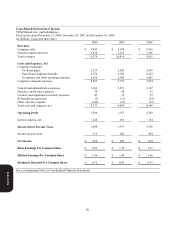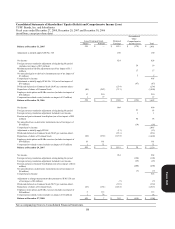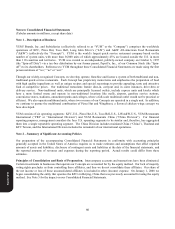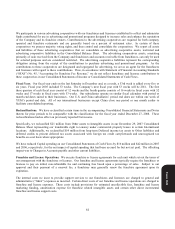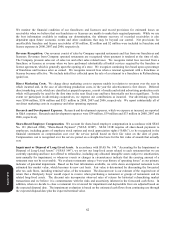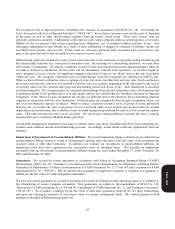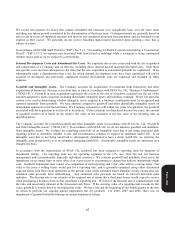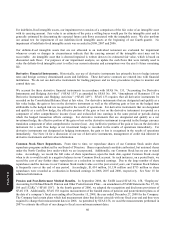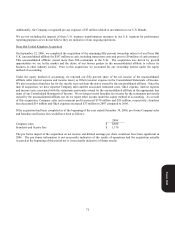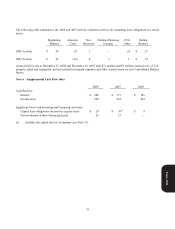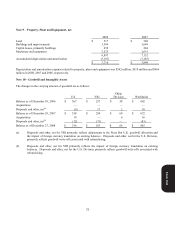Pizza Hut 2008 Annual Report Download - page 187
Download and view the complete annual report
Please find page 187 of the 2008 Pizza Hut annual report below. You can navigate through the pages in the report by either clicking on the pages listed below, or by using the keyword search tool below to find specific information within the annual report.
65
We record rent expense for leases that contain scheduled rent increases on a straight-line basis over the lease term,
including any option periods considered in the determination of that lease term. Contingent rentals are generally based on
sales levels in excess of stipulated amounts, and thus are not considered minimum lease payments and are included in rent
expense as they accrue. We generally do not receive leasehold improvement incentives upon opening a store that is
subject to a lease.
In accordance with FASB Staff Position (“FSP”) No. 13-1, “Accounting for Rental Costs Incurred during a Construction
Period” (“FSP 13-1”), we expense rent associated with leased land or buildings while a restaurant is being constructed
whether rent is paid or we are subject to a rent holiday.
Internal Development Costs and Abandoned Site Costs. We capitalize direct costs associated with the site acquisition
and construction of a Company unit on that site, including direct internal payroll and payroll-related costs. Only those
site-specific costs incurred subsequent to the time that the site acquisition is considered probable are capitalized. If we
subsequently make a determination that a site for which internal development costs have been capitalized will not be
acquired or developed, any previously capitalized internal development costs are expensed and included in G&A
expenses.
Goodwill and Intangible Assets. The Company accounts for acquisitions of restaurants from franchisees and other
acquisitions of businesses that may occur from time to time in accordance with SFAS No. 141, “Business Combinations”
(“SFAS 141”). Goodwill in such acquisitions represents the excess of the cost of a business acquired over the net of the
amounts assigned to assets acquired, including identifiable intangible assets and liabilities assumed. SFAS 141 specifies
criteria to be used in determining whether intangible assets acquired in a business combination must be recognized and
reported separately from goodwill. We base amounts assigned to goodwill and other identifiable intangible assets on
independent appraisals or internal estimates. If a Company restaurant is sold within two years of acquisition, the goodwill
associated with the acquisition is written off in its entirety. If the restaurant is refranchised beyond two years, the amount
of goodwill written off is based on the relative fair value of the restaurant to the fair value of the reporting unit, as
described below.
The Company accounts for recorded goodwill and other intangible assets in accordance with SFAS No. 142, “Goodwill
and Other Intangible Assets” (“SFAS 142”). In accordance with SFAS 142, we do not amortize goodwill and indefinite-
lived intangible assets. We evaluate the remaining useful life of an intangible asset that is not being amortized each
reporting period to determine whether events and circumstances continue to support an indefinite useful life. If an
intangible asset that is not being amortized is subsequently determined to have a finite useful life, we amortize the
intangible asset prospectively over its estimated remaining useful life. Amortizable intangible assets are amortized on a
straight-line basis.
In accordance with the requirements of SFAS 142, goodwill has been assigned to reporting units for purposes of
impairment testing. Our reporting units are our operating segments in the U.S. (see Note 20) and our business
management units internationally (typically individual countries). We evaluate goodwill and indefinite lived assets for
impairment on an annual basis or more often if an event occurs or circumstances change that indicate impairments might
exist. Goodwill impairment tests consist of a comparison of each reporting unit’s fair value with its carrying value. Fair
value is the price a willing buyer would pay for a reporting unit, and is generally estimated using either discounted
expected future cash flows from operations or the present value of the estimated future franchise royalty stream plus any
estimated sales proceeds from refranchising. Any estimated sales proceeds are based on relevant historical sales
multiples. The discount rate is our estimate of the required rate of return that a third-party buyer would expect to receive
when purchasing a business from us that constitutes a reporting unit. We believe the discount rate is commensurate with
the risks and uncertainty inherent in the forecasted cash flows. If the carrying value of a reporting unit exceeds its fair
value, goodwill is written down to its implied fair value. We have selected the beginning of our fourth quarter as the date
on which to perform our ongoing annual impairment test for goodwill. For 2008, 2007 and 2006, there was no
impairment of goodwill identified during our annual impairment testing.
Form 10-K



